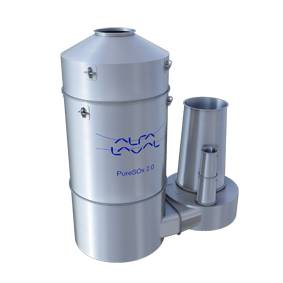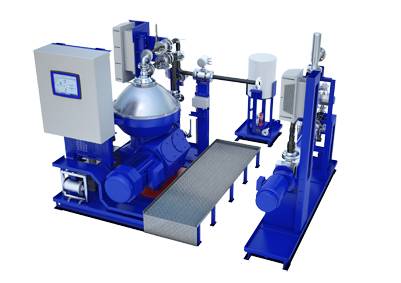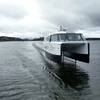Alfa Laval Announces PureSOx 2.0
Alfa Laval said its PureSOx is one of the market-leading alternatives for complying with the sulphur limits imposed by MARPOL Annex VI and its guideline MEPC 184(59), and with January 2015 and the enforcement of Emission Control Areas (ECAs) rapidly approaching, the company has launched a new generation of the scrubber with a wide range of enhancements and options: PureSOx 2.0.
PureSOx has been operating at sea since 2009 and is among the most prominent scrubbers on today’s market, Alfa Laval said, noting that it is also one of the most widely sold, having generated orders for 50 systems on 45 vessels. Now a new generation of the system, PureSOx 2.0, has been presented at this year’s SMM in Hamburg.
Smaller and more flexible, PureSOx 2.0 suits an even wider range of vessels and offers benefits from the design stage to ongoing operation. These include new placement possibilities and lower installation costs, as well as the option of powder dosing in closed-loop mode. “PureSOx 2.0 retains the well-documented PureSOx strengths,” said René Diks, Alfa Laval Manager Marketing & Sales, Exhaust Gas Cleaning. “What it adds are new advances that reinforce the system’s position at the leading edge of marine scrubber technology.”
PureSOx 2.0 is not a departure, but rather a milestone in a continuous development process, Alfa Lavalsaid. Though refined with experience over time, the PureSOx technology is still fundamentally the same as that of the very first PureSOx system, which still serves the two-stroke 21 MW main engine aboard the DFDS Ficaria Seaways.
“Every PureSOx system ever installed is in use and operating within ECA limits,” said Diks, who points out that PureSOx today has more references than any other single SOx scrubber technology. “PureSOx 2.0 is more of an evolution than a revolution,” he explains, “but the benefits are so significant that they call for a new version name.”
Perhaps the most evident difference in PureSOx 2.0 is the diameter of the absorber, which forms the bulk of the scrubber body. This has been reduced by around 15%, which lessens the likelihood that cargo or passenger space will be affected by the scrubber installation. Further reduced is the size of the control system, which is a full 50% smaller than the previous version.
Even the water cleaning unit used in closed-loop mode – already the most compact solution of its kind – is now easier to get on board. The unit is significantly more modular in PureSOx 2.0, with equipment now distributed across three skids. These can be loaded onto the vessel separately, and their independent placement allows greater flexibility in design.
“Size and flexibility are of primary importance when integrating a scrubber into the vessel,” said Diks. “PureSOx 2.0 makes a real difference in these respects, especially in a retrofit.”
In fact, PureSOx 2.0 opens up a range of design opportunities, allowing it to be even more effectively integrated. For example, it is designed to handle boiler exhaust, which removes the need for an additional exhaust gas cleaning system when the boiler is fired with HFO. “PureSOx was developed from the beginning as a multiple-inlet system, able to clean the exhaust gas from several engines,” Diks explained. “PureSOx 2.0 takes this one step further, allowing a single scrubber to handle the exhaust from main engines, auxiliary engines and boilers.”
Moreover, the scrubber itself attenuates noise in PureSOx 2.0. This means it can now be positioned before the silencer, rather than after as previously required. Especially in a newbuild, this means it can be placed lower in the vessel. Not only does this improve vessel stability, it also has the benefit of reducing back pressure. “Lowering the pressure will ease the burden on the engine,which may have a positive effect on the vessel’s fuel consumption.”
When it comes to operation, the most notable difference in PureSOx 2.0 is the option of powder dosing, which applies to both closed-loop and hybrid configurations. When running in closed-loop mode, the circulation water must be dosed with an alkaline additive. Up to now this has always been the liquid additive caustic soda, but in PureSOx 2.0 a powder like sodium bicarbonate can be used instead. Taken aboard dry and loaded into a silo, the powder is mixed with desalinated water before entering the closed-loop circuit.
“For the crew there is an immediate benefit in powder dosing, since it reduces the risks involved when handling the consumables,” Diks said. “The long-term advantage is the fact that powder additives are less expensive. When powder dosing is chosen, there is a reduction in operating costs that offsets the equipment investment.”
Alfa Laval said the release of PureSOx 2.0 offers significant benefits for ship owners and operators, as well as the shipyards they employ. Nonetheless, Diks emphasized its place as part of a total effort in emission control, which includes the new Alfa Laval Test & Training Centre in Aalborg, Denmark. Equivalent to a full-sized engine room on land – complete with all major process lines – this facility provides opportunities to further refine PureSOx and explore its interaction with other technologies on board.
“PureSOx 2.0 is a system we are extremely proud of. It represents a major milestone, both in terms of the PureSOx technology itself and in terms of Alfa Laval’s overall commitment to exhaust gas cleaning,” Diks said. “But development will continue, both at Alfa Laval’s own R&D facilities and at sea in cooperation with our customers.”
alfalaval.com
dfdsseaways.co.uk
















